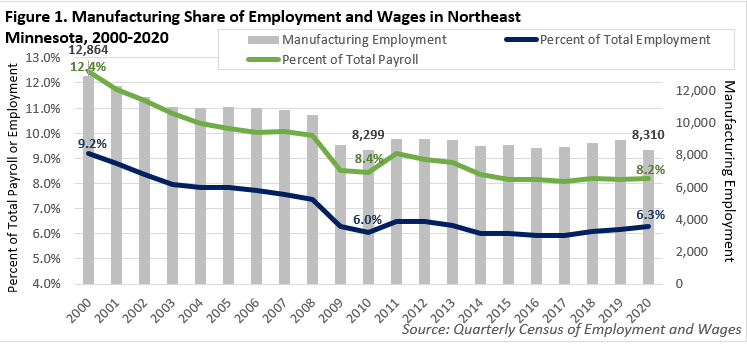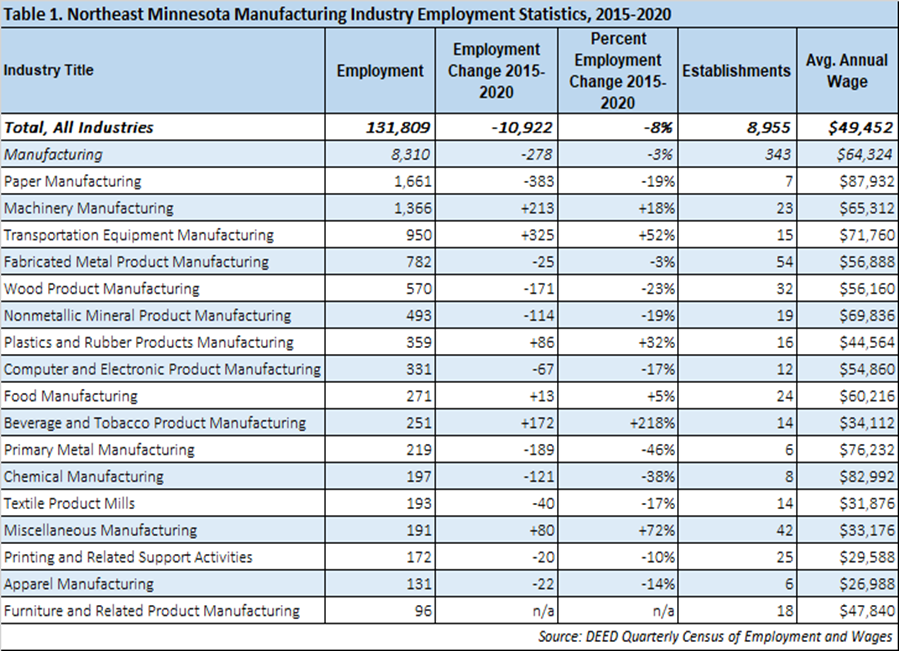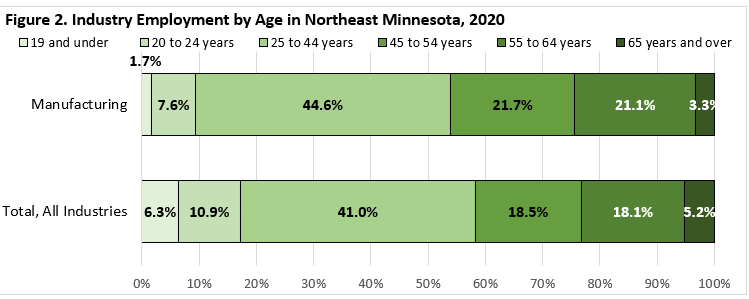 Home to the state's second-largest metro, the Northeast Region has a strong industrial sector, tied largely to the area's abundant natural resources.
Home to the state's second-largest metro, the Northeast Region has a strong industrial sector, tied largely to the area's abundant natural resources.
Most of the manufacturing base centers on mining and forest products industries. More than half of the sector's employment is in paper and machinery manufacturing.
Want the freshest data delivered by email? Subscribe to our regional newsletters.
9/27/2021 9:00:00 AM
Carson Gorecki
The Manufacturing sector has long been an integral component of Northeast Minnesota's economy. With 8,349 jobs in 2020, Manufacturing was the 6th largest employing sector in the region, accounting for 6.3% of all jobs. The number and share of Manufacturing jobs has declined since 2000, yet the sector continues to have a larger impact than may appear from employment levels alone. The sector's $64,057 average annual wage is nearly $15,000 larger than the average wage in the region. Accordingly, Manufacturing's total annual payroll of nearly $535 million represents over 8% of the region's wages paid to all industries in 2020 (see Figure 1).
Encouragingly, the decline of Manufacturing employment leveled out and even reversed in recent years, indicating a potential turnaround for the sector if trends resume out of the pandemic. As if to confirm that inflection point, recent deals to open an engineered-wood factory and reopen a shuttered paper manufacturing plant were inked in the region in 2021 for an estimated 230 Manufacturing jobs, which may lead to continued growth.

As implied, the quality of Manufacturing jobs is also important to consider when assessing an industry's influence. The industry is high paying and offers good opportunities. Of the 127 Manufacturing job vacancies recorded in the 4th quarter of 2020, all were full-time and the median wage offer of $26.98 per hour was nearly double that for all industries. At the same time, only 8% of those vacancies required applicants to have a specific certificate or license to qualify, making the sector appealing and accessible to a broad range of workers.
The Manufacturing sector includes a diverse array of industries producing everything from transportation equipment to paper to foodstuffs. The largest-employing industries in Northeast Minnesota include Paper Manufacturing, Machinery Manufacturing, and Transportation Equipment Manufacturing. Combined, these three industries account for nearly half of all regional Manufacturing jobs in our region.
The COVID-19 pandemic impacted most industries, including Manufacturing, negatively. Manufacturing saw a decline of almost 600 jobs from 2019. Those 2020 losses were smaller than the average across all industries, yet erased the modest employment gains that occurred in the sector since 2015. However, within the Manufacturing sector there were also some notable bright spots. Transportation Equipment Manufacturing, Machinery Manufacturing, and Beverage & Tobacco Manufacturing – which more than doubled – saw the largest increases. Plastics & Rubber Products and Food Manufacturing also added jobs from 2015. On the negative side, Paper Manufacturing experienced the largest losses at nearly 400 jobs, followed by Primary Metal, Wood Product, Chemical, and Nonmetallic Mineral Product Manufacturing, which each lost more than 100 jobs since 2015 (see Table 1).

The region's Manufacturing workforce is predominantly white and male. According to DEED's Quarterly Employment Demographics, 3.9% of Manufacturing workers in Northeast were people of color in 2020, compared to 7.3% of all workers. At the same time, the number of workers of color has grown 7% since 2015 while white employment declined 18%. By gender, only 21.5% of workers were women. This was a slight increase from 19.6% in 2010, but was only enough for the 5th smallest share of female workers among the 20 sectors behind Mining, Construction, Transportation & Warehousing, and Wholesale Trade. The median hourly wage for the Manufacturing jobs held by women was $19.82, which was 74% of the median wage for men. The gender pay gap in Manufacturing was larger than the industry average, which sat at 80% in 2020.

The age of employees is another way that the Manufacturing sector differs from others in the region. There are smaller shares of the youngest and oldest employees in the Manufacturing sector when compared to all other industries (see Figure 2). The Manufacturing sector has the 5th smallest percentage of workers 65 years and older yet also has the 4th largest share of workers 55 to 64 years of age. This imbalance indicates that Manufacturing workers tend to retire or change industries closer to the traditional retirement age of 65 than many other industries, and also highlights the future need for workers to replace them.
These age trends represent an opportunity for the sector to bring in workers that are not part of the traditional Manufacturing workforce. Workers of color, women, and younger workers are three groups that employers can look more closely at to address increasingly urgent hiring needs.
Contact Northeast Minnesota Labor Market Analyst Carson Gorecki at 218-302-8413.